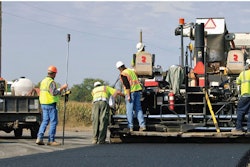
The labor shortage only gets worse as time goes on, and if you want proof of the dreary news the Associated General Contractors of America’s latest survey paints a gloomy picture for the present.
But in presenting the survey results to the press, the AGC also brought in some key construction contractor members to talk what they’re doing to fight the shortage. These initiatives, both at an AGC national and state chapter level and at the level of individual construction companies, are getting results and helping to turn the tide. In particular, a program in Oregon to show teachers and school administrators the benefits of a construction career and a program in Houston to require locally trained craft workers are arguably the most creative ideas to come from the industry in decades.
AGC partnered with Autodesk for the survey which gathered responses from more than 2,500 construction firms and found that the overwhelming majority, 80 percent, were having a hard time filling craft worker/hourly positions and salaried jobs, says Ken Simonson, AGC’s chief economist. That total is up from the 78 percent reporting difficulty in a January survey and up from 73 percent reporting the same in a January 2017 survey.
The five hardest craftworker positions to fill include: pipe layers, sheet metal workers, carpenters, concrete workers and pipefitters/welders. The five hardest salaried positions to fill were managers/supervisors, estimating personnel, quality control personnel and Building Information Modeling (BIM) personnel.
Job openings in construction have soared in recent months according to the Bureau of Labor Statistics and the number of unemployed construction workers has been low lately. “In other words, contractors are spending longer filling jobs and having fewer experienced workers to choose from,” Simonson said. “It appears that labor shortages are not going away anytime soon,” he says.
A copy of the survey results, including breakouts for 34 states, can be found here.
The survey respondents also listed some of the ways they’re trying to find more workers on a company level including:
- Incentives and bonuses to attract workers: 34 percent
- Increased pay: 62 percent
- More in-house training: 46 percent
- Hiring interns: 30 percent
- Used more overtime: 30 percent
- Changing hiring standards: 26 percent
- Getting involved with career building programs in local schools: 48 percent
- Using staffing firms: 32 percent
- Using more specialty subcontractors: 28 percent
- Using prefabrication and computer modeling to improve efficiency: 25 percent
And while the numbers aren’t dramatic, the workforce shortage has had an appreciable effect on jobsite safety, said respondents. Fifteen percent reported an increase in injuries and illnesses, 14 percent said it increased the number of jobsite hazards and 10 percent saw and increase in the number of workers compensation claims.
Retooling the workforce development plan
AGC has retooled its workforce development plan which it issued in 2013, says Simonson, and is releasing an updated version of that plan that identifies steps federal officials should take, including doubling the amount of money invested in Career and Technical Education at the federal level over the next five years.
It also calls for reforms to our immigration laws that will allow more people with construction skills to legally enter the county and lists steps the AGC is taking to recruit people into high paying construction careers, including launching a new targeted digital advertising recruitment campaign and investing in a series of workforce development initiatives created by member firms’ chapters.
Teach the teachers
Steve Malaney, president, P&C Construction, Portland, Oregon, says the big challenge in Oregon was finding a way to reach as many people as possible. Career days at schools were reaching thousands of students but only for 10 to 15 minutes each.
The chapter decided to develop a program that gave teachers, principals and guidance counselors a stipend to spend two weeks in the summer to learn about all the opportunities in the construction industry, develop a lesson plan for their students and get some college credits for it as well. In addition to site visits, the subjects cover everything from basic construction skills to back office administration and marketing, project management, supervision and suppliers.
“Our goal was to make the teachers a champion for the industry. We’ve grown the program from 12 teachers the first year to 70 teachers in five locations this year,” says Malaney. “And we already have people lined up for next year and will surpass our numbers. Our goal now is to share this program with other contractors and AGC chapters across the country.”
Social media works
Yohn Baldwin, president of Baldwin General Contractors, Albany, Oregon, and the chairman of the Oregon AGC workforce committee, says their chapter invested in hiring two staff members to develop a more robust workforce plan. The chapter updated their website and created a second website, “Build Oregon,” which reaches out to a younger demographic, but didn’t see the numbers change appreciably. That spurred the creation of a media outreach campaign. They hired a media marketing consultant and developed a Twitter feed while purchasing advertising on Twitter and Facebook and using other social media tools.
“We’ve gotten tens of thousands of hits on our site and people repeatedly coming back,” says Baldwin. “So we made the decision to go ahead and put more resources behind this objective and we’re laying out plans for a phase three to give this a broader reach. Social media is something most of us might not be as familiar with as young people but there is a lot of opportunity to daylight this industry.”
C3 in Houston
Chuck Gremillion is the executive director of the Construction Career Collaborative (C3) in Houston, Texas. C3 is a not-for-profit alliance of building owners, contractors and specialty contractors, whose purpose is the create a safe, skilled and sustainable craft workforce in the greater Houston region, says Gremillion.
What makes C3 unique is that construction companies and project owners are specifying it in their bids and contracts. To date Houston has 10 high profile owners that have included C3 requirements in construction contracts totaling 27 projects at a value that exceeds $2 billion, says Gremillion. These include health care facilities, a museum and a 47-story building.
C3 is truly a collaborative effort, says Gremillion. “It is merit shops and union shops, general contractors and specialty contractors, architects and building owners all working together to overcome an industry challenge that impacts them all.”
“Companies must convince young people, their parents and school counselors that a career in the construction industry is a ticket to a safe, rewarding and prosperous career,” Gremillion says. “C3 achieves this with a focus on employment practices, safety training and skills training linked to career paths. The safety metrics on projects designated as C3 projects are proving to be much better compared to the industry as a whole according to the BLS.”
Dan Gilbane, Gilbane Building Company and a member of the AGC Houston board, is a partner in the Upscale Houston initiative, which is a skilled workforce development program launched four years ago to bring the construction industry and other industries facing worker shortages together and create local solutions.
“We really need a collective solution to provide essential leadership and partner with educational community organizations, and leadership that’s engaged with the policy making decisions,” says Gilbane. “What we aim to do is foster the collective solutions that are necessary to address these challenges.”
An essential part of Upscale Houston’s mission is to provide clear career paths, says Gilbane.
“A lot of these career paths won’t require a four-year degree,” he says, “but that won’t end someone’s educational journey. Typically that often complements it. You can start a career, develop the relevant technical skills, become financially self-sufficient and explore where it takes you from there, whether it’s a craft professional all the way up to being CEO of a company. In a lot of ways, it’s the American dream.”













